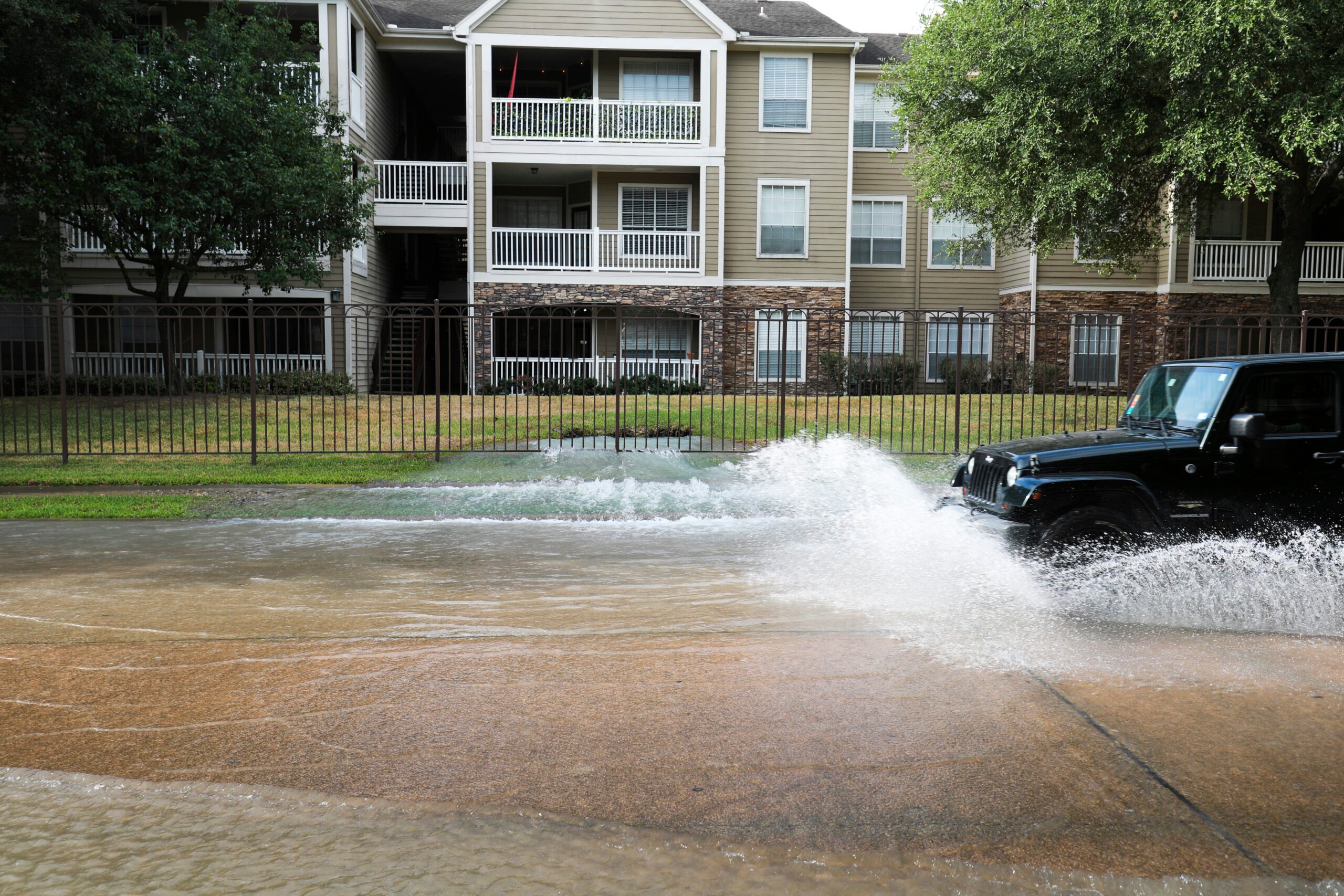In June 2016 — the hottest June in recorded history — I drove down to the Chisos Mountains with a photographer, our car speeding along the silent desert bottoms within Big Bend National Park. The Chisos are the southernmost of the “sky islands,” isolated remnants of forest stranded in the middle of the desert by ancient fluctuations in climate. The Chisos’ red-rock slopes are filled with pines, oaks, junipers and relict cypresses, and with rare species unlike any found for hundreds of miles around. The result is an ecosystem unique within the Big Bend. It’s a place of delicate balance between fiercely competing plants, many living at the edge of their geographic ranges and tolerances for temperature and aridity. It’s an ecosystem on a knife edge, dependent on regular rains and steady temperatures. So in 2011, when drought devastated vast regions of Texas, the results in the Chisos were, even by that year’s standard, particularly dire.
The Chisos received only 4.3 inches of rain, on top of a winter cold snap that left the sky islands more vulnerable to heat and dryness. “By about May or June, it started to look pretty bad,” recalled Joe Sirotnak, Big Bend’s park botanist. “Usually the monsoons arrive by summer, but it just wasn’t happening.” Rangers and scientists working in the Chisos watched trees falter. Snags proliferated through the mountains, many of them younger trees. “We lost over 60 percent of the trees in some plots,” Sirotnak said. In his 15 years working in the park, he said, he’d never seen anything quite as bad.
Five years later, the upper regions of the Chisos are still largely forested. But the wide scale of tree deaths, stretching over the mountains in swaths of lifeless gray, still alarms rangers and scientists. It’s a harbinger of what could come, the warming of an already dry, hot region to a tipping point. The dead piñons, oak and juniper signal that the survival of the relict Chisos ecosystem is by no means certain, especially if, as climate scientists predict, more intense heat brings sustained, severe dryness, even fires. The 2011 drought that rocked the mountains is a warning shot, a sign of what could happen as the Southwest succumbs to the effects of a changing climate. We had come to observe that struggle for ourselves.
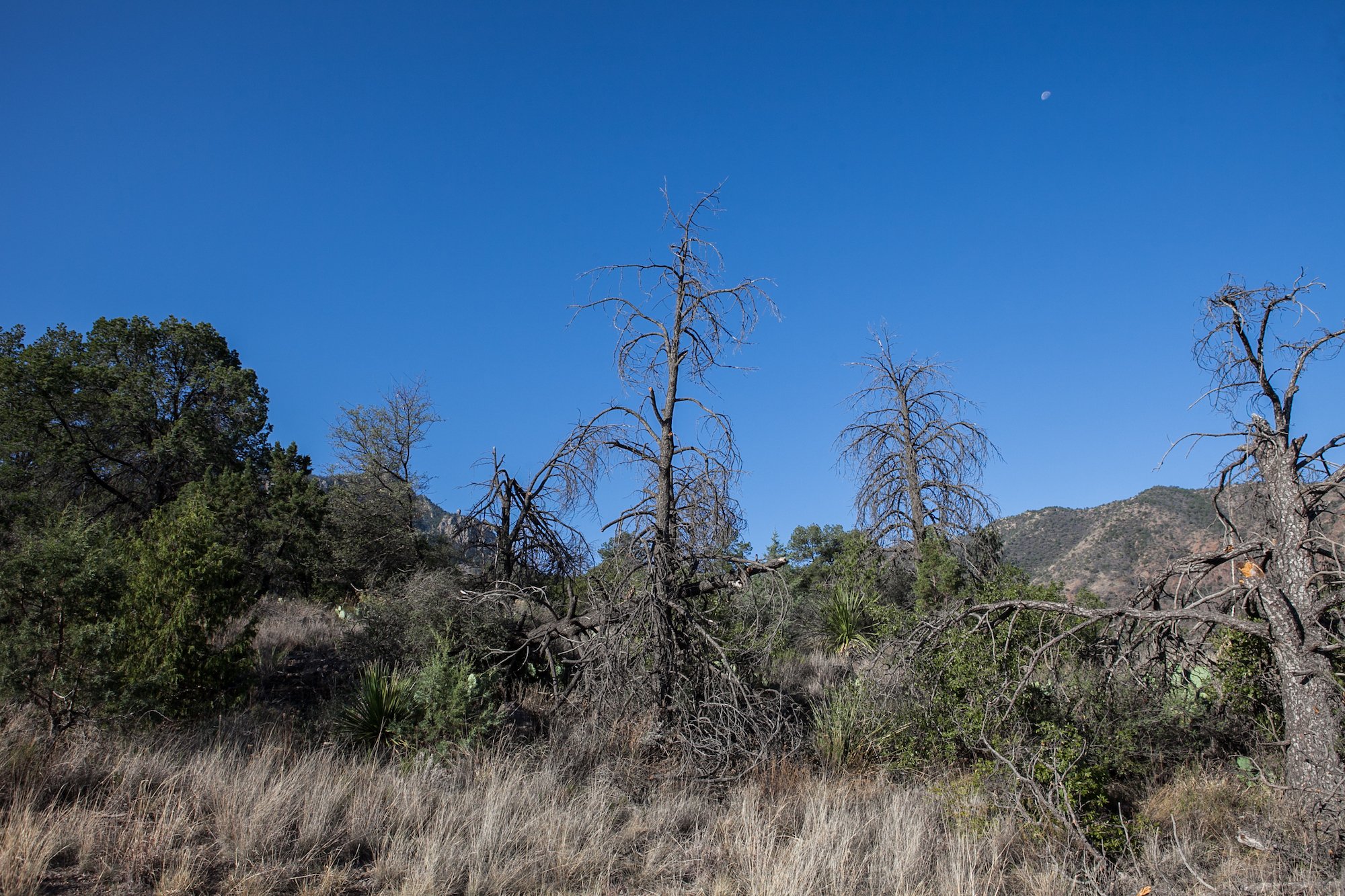
The morning after we arrived, we walked out into the parking lot of the visitor center to meet our guides. Sirotnak arrived with three others in tow — a volunteer, a seasonal ranger and botanist, and Maria Lavender, a park ranger. Together we buckled on backpacks heavy with water and followed them onto one of the many trails winding up the slopes. As we walked, the botanists pointed out trees and shrubs — the corrugated, scaly bark of the alligator juniper, the drooping boughs of its cousin, the weeping juniper, and thin, scrappy trunks of Emory oaks. We passed through meadows of pale yellow grass dominated by juniper and spindly oaks. A few hundred feet up a stone-edged trail lined with switchbacks, we came across a stand of dead piñon pine, gray trunks bare and flaking over the brittle ground. The piñon, not especially tall or lush, is not a terribly charismatic tree. But it is an important one, Sirotnak says. Piñon have historically made up a large part of the Chisos forests, providing shade for smaller plants and producing a fatty, nutritious nut that feeds both wildlife and people. This far south, piñons are confined to the sky islands of the Guadalupe Mountains and the Chisos. “We’re right at the edge of where you can grow piñon,” Sirotnak said, rubbing a needle between weathered fingers. “You go to a hotter environment, the junipers will still hang on, but the piñons drop right out.”
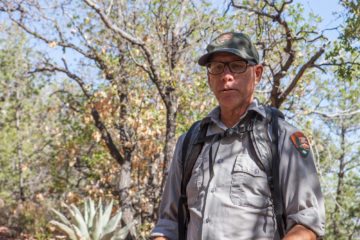
The 2011 combination of freeze and drought affected not only the piñon trees. The damage to the forest was recorded in a 2014 paper by Helen Poulos, an environmental scientist at Wesleyan University. Poulos had been working with the park service since 2009 on a long-term research project that studied the Chisos forest’s reaction to thinning and burning. As part of that study, she’d set aside control plots of land at various elevations in the mountains, counting the numbers of tree species within them. When she returned to the Chisos in 2012, she found something she hadn’t expected. “One of the first things I saw up near the visitor center was this tree that had actually split open from the freeze,” she recalled in a phone interview. “It was really surprising. … Any place that you work in for a long time, that you love or that you have memories about, the plants there are kind of like old friends. So when you see all of these dead trees out on the landscape, it’s shocking or upsetting sometimes.”
In effect, she said, the freeze and drought had been a deadly one-two punch. Ice crystals grew inside many of the Chisos trees, wreaking havoc on the internal network that distributes water through the plant. When the freeze ended, melting ice left pockets of air inside the capillaries, which interrupted the flow of water and created deadly embolisms. In the drought that followed, the intense heat pulled water from the leaves, straining the column of water pumped from the roots. With little water in the ground, the water columns split under the pressure, causing more embolisms. The trees died from the tips back, their internal plumbing wrecked. Sixty-two percent of the trees in Helen’s research plots were dead when she surveyed them. The Emory oaks and alligator junipers lost a respective 40 percent and 20 percent of their trees. But the piñon pines, one of the most common trees in the Chisos, were hit the hardest: 54 percent of the broad, brushy trees died, saplings and adults alike. The shrubs sheltering in their shadows wilted beneath the blazing sun.
The drought proved particularly devastating for the piñons due to a quirk of evolutionary biology. According to Dylan Schwilk, an ecologist at Texas Tech University working on the question of climate change in sky islands, pines are superficially tolerant to dry weather. “They have this amazing ability to shut down [during drought] because they have these waxy needles, so they can actually close their pores and stop water loss,” he said. “But the problem is, if plants don’t have their pores open, they’re not getting carbon dioxide in. A plant’s job is to make sugar out of air, and if they can’t get that air, they starve to death.”
Diebacks such as the loss of the piñon pines can have immediate effects, Sirotnak said. The pines are already largely wiped out from the South Rim of the Chisos, a sweep of slope constantly exposed to the sun. The rest of the forest there is suffering as a result. “Once you remove the shade, the ground becomes even hotter and dryer,” Sirotnak said. Lose enough trees in an ecosystem such as this, Sirotnak mused, and the forest converts to chaparral, the welter of shrubs, stumpy trees and thorn bushes familiar to anyone traveling through West Texas.
Alternatively, the dieback of piñon may open an opportunity for trees able to bounce back more quickly from disaster, species such as oaks, which sprout in the mid-elevation forests in the Chisos or grow in the shelter of its moist canyons. Oaks are not as outwardly hardy as pines and junipers, perishing easily under drought conditions. But they have a secret weapon — dormant buds and deep carbon storage that can fuel regrowth after their branches die. Schwilk said that while they might be more susceptible to dry weather in the short term, they could end up replacing the piñons in the long term.
The effects of such a transition are hard to pin down, Schwilk continued. Birds will miss the canopies created by pines, and the loss of their piñon nuts may also affect wildlife. But a bigger crop of acorns might offset the loss, and most importantly, the oaks will keep the ground shaded enough for smaller plants. A reign of oaks might prove the best-case scenario for a changing forest. Or the piñons could recover. “We get a wet enough decade, they might come back,” Sirotnak said, then shrugged. “They might not. Nobody wants to run a 30,000-acre experiment to find out.”
As we came over the ridgeline the forest shifted, and dead gray pines poked through the surviving junipers. We stood on the hillside for a moment, looking south. Up on the heights it was a pleasant 80 degrees, and a cool wind brushed our faces. Agave plants waved in the breeze on the dry hillsides. Clouds massed in the blue distance behind the snags, a thunderhead building over the hazy mountains of the Mexican border.
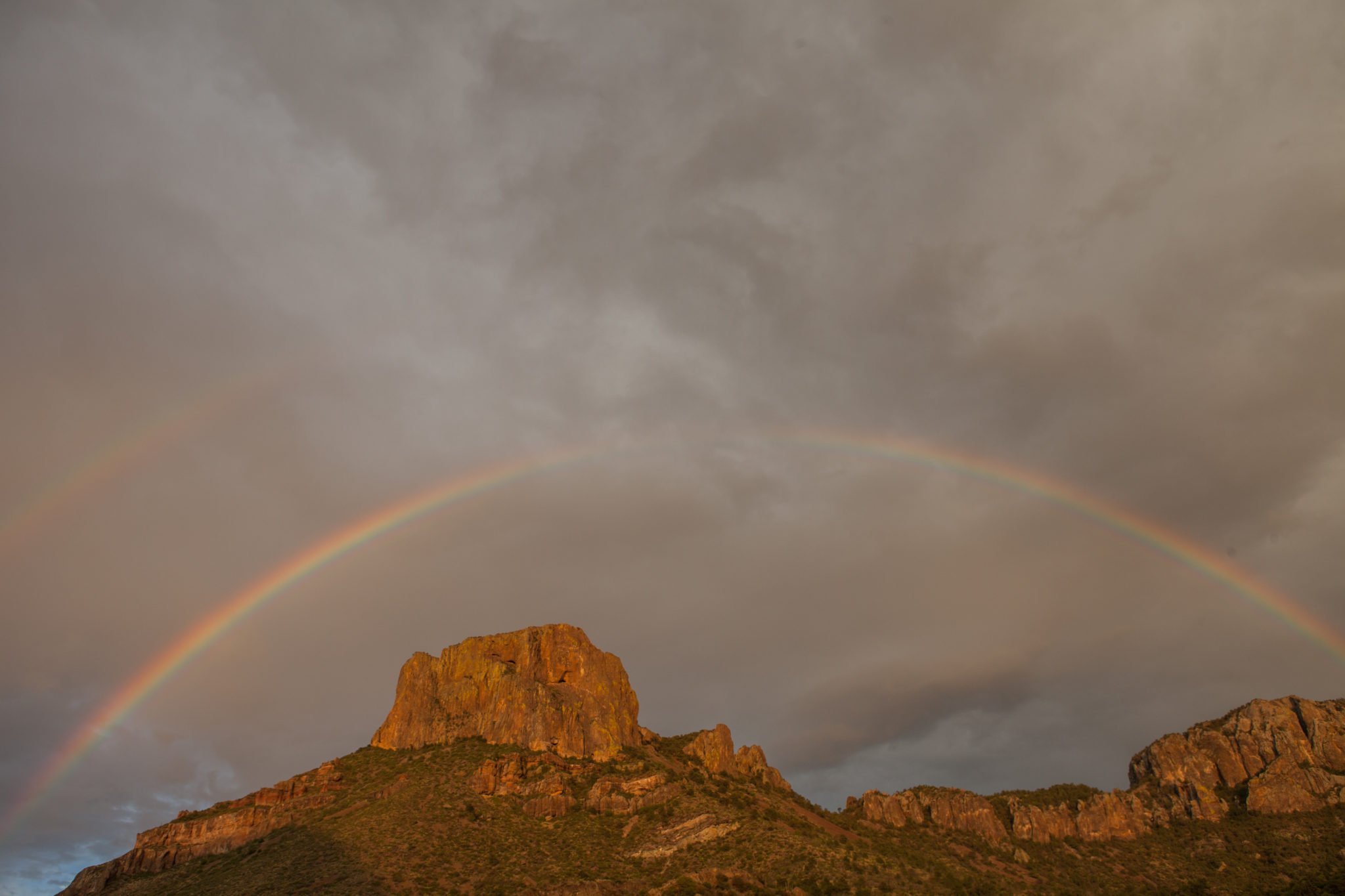
We entered the cool cover of Boot Canyon in the early afternoon. The valley sits in the lee of the South Rim, protected from the blazing sun and nourished by cool air coming off the peaks. The sheltered forest is thick with ice-age era refugees and specialized species found almost nowhere else in Texas — Arizona cypress, ponderosa pine, Douglas firs, tiny orchids that feed on leaf litter and the incredibly rare, stringy grass called Guadalupe fescue. As we hiked in, a profusion of lizards scattered away from our feet. A 3-foot rattlesnake stretched on a rock shelf above the trail.
“It stays fairly wet down here,” Sirotnak said, pointing at the greenery. The valley is high enough in the mountains to catch water from storms, and suffers less evaporation due to facing east. As a result, Sirotnak said, “the summer frequently has actual surface water running down the bottom of the canyon.”
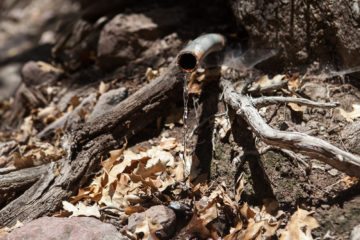
He was right. We stopped to rest and refill our water bottles at a seasonal spring nestled beside the dry creek bed, the water pouring in a steady stream from a little pipe set between the roots of a broad oak tree. “We don’t tell people about this spot,” Lavender said. “We don’t want people to rely on being able to refill their water here, since the spring isn’t always flowing. You can get into trouble that way.” The springwater had a flat, metallic taste, but it was cold and refreshing after the heat.
Boot Canyon feels like an oasis even within the comparative green of the Chisos Mountains. But while these forests didn’t suffer as badly as the piñons, they’re equally vulnerable to another drought-related threat: fire. The Chisos haven’t had a natural wildfire since 1903. Before that, Lavender said, reports by ranchers describe broad swaths of open woodland inside the basin, kept clear by small fires that were likely ignited by Indian tribes to maintain the meadows. When the Chisos became part of a national park in 1943, fires were suppressed, in keeping with the general consensus at the time about forest management. Now the mountains are clogged with dead wood and bracken, and there’s neither the money nor the political will to set controlled burns to help clear it out.
“It just became very, very expensive to do a prescribed fire, especially in this environment where you’re so far from roads,” Sirotnak said. “You have to hike everything in, probably have to have a helicopter standing by.” After a 2006 fire got out of control on the South Rim, he said, nobody in the park service has even tried. Then the 2011 drought left more dead wood in the mountains than ever. “We can thin, but we can’t burn,” Sirotnak said. “If this forest that many people love went up in flames…” Sirotnak shook his head. “Put it this way: No superintendent wants to have their name attached to the great catastrophic fire of the Chisos Mountains.”
In 2011, rangers closed the trails completely, Lavender said, worried that a stray cook fire would ignite the parched forest. There are still strict regulations forbidding campers from using fires, though the rangers said they often find people building them anyway. If such a fire does get started on one of the dry, windy mountainsides, Sirotnak said, it could easily rage into a crown fire that sweeps up the valleys and ridges, devouring everything in its path. The results could simply wipe the forest away in what Sirotnak ominously calls a full ecosystem conversion.
The photographer and I turned back after Boot Canyon; Sirotnak and the others headed further up to hike the battered South Rim. Retracing our steps out of the canyon, we marveled at the diversity of life around us. Cactus of every shape and size perched in the rock scree beside curled ferns and piles of golden oak leaves. Agave had sent up 9-foot stalks tipped with canary-yellow flowers, the petals buzzing with gnats, butterflies and the occasional jewel-like hummingbird. Fresh bear scat dried on the trail, and deer with velvet antlers grazed placidly on the bushes. When we reached the top of the ridgeline we looked back to see the thunderheads rolling over the desert, towers of black and purple clouds sliding toward us. Around us, oak leaves rattled in the wind.
Long-term climate trends are the most important factor in the Chisos’ fate. The Southwest has been growing warmer and drier since the Pleistocene. The question now is what effect rapid global temperature increases will have on the Chisos. According to State Climatologist John Nielsen-Gammon, there’s a broad consensus in the climate models regarding a steady increase of temperature in the Southwest. There’s somewhat less certainty regarding the possibility of lower rainfall: Nielsen-Gammon says about 70 percent of the models predict lower precipitation, but there just isn’t a good historical baseline of data to work from.
“We think we’ll still see the cycles of extreme wet and extreme dry in the future that we see today,” said Katharine Hayhoe, a climatologist at Texas Tech who works occasionally with Nielsen-Gammon. Since 2013, Schwilk, Poulos, Hayhoe and others have been working on a U.S. Department of the Interior-funded project to study the effects of climate change on sky island forests. There’s been relatively little collection of temperature data in the Chisos up to this point; the mountains are too remote and few people live there. Add in the complicated topography of the mountains, and it’s hard to make local, accurate predictions. Certainly, Hayhoe said, the increases in temperature will worsen the droughts. “When it’s warmer … what water there is evaporates more swiftly from the soil and can evaporate reservoirs,” she said. “So that exacerbates the impacts of the drought on the wildlife as well as on the plants.”
What Schwilk’s team uncovers will help answer the question of whether the 2011 drought marked a temporary setback for the Chisos forests or the start of something more serious. While it’s impossible to predict the future of an ecosystem with any certainty, what is certain is that the forest is going to change. “Climate change is not something new,” Schwilk said.
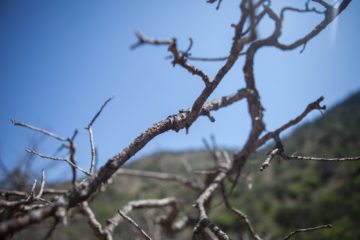
Conservationists and park officials have begun to realize that parks, far from being protected islands, are constantly affected by the landscapes around them, he went on. “So to pretend that you can hold things in complete stasis is a fantasy,” he said. “And that’s recognized. I personally think that there’s some value in trying, even if it’s not possible. You just have to be honest about what you’re managing for.”
Sirotnak and the Park Service are overseeing the park as best they can, cutting back brush, pulling up invasive weeds and trying to lower the risk of fires. “The reason we’re concerned about climate change today is because it’s happening so fast,” Hayhoe said. “It’s happening about 10 times faster than it did between the last ice age and today. And that could be even faster by the end of the century.” For the people trying to manage the Chisos in the face of that level of transition, it’s hard to do more than hang on for the ride.
Thunderheads rolled in as we came down the slopes. Clouds hid the upper peaks, shrouding the hidden valleys and sending double forks of lightning into the cliffs. Then the rain came, slow at first, then harder, falling in drenching sheets. The water poured down on a small piñon growing beneath a dead elder, droplets beading on the waxy needles. What the future holds for such trees, nobody quite knows. This time, though, the storm had come.


